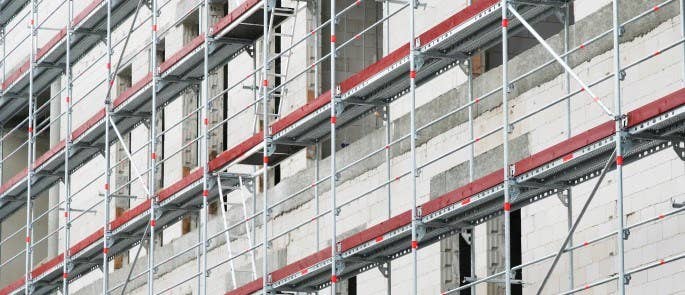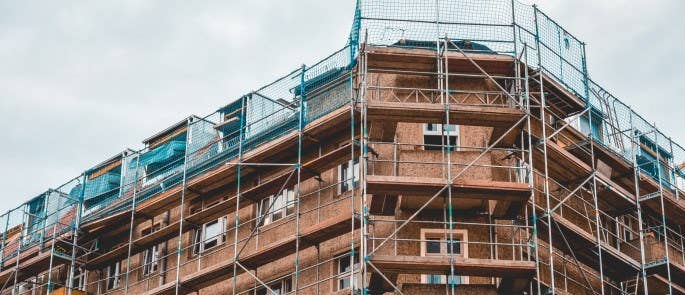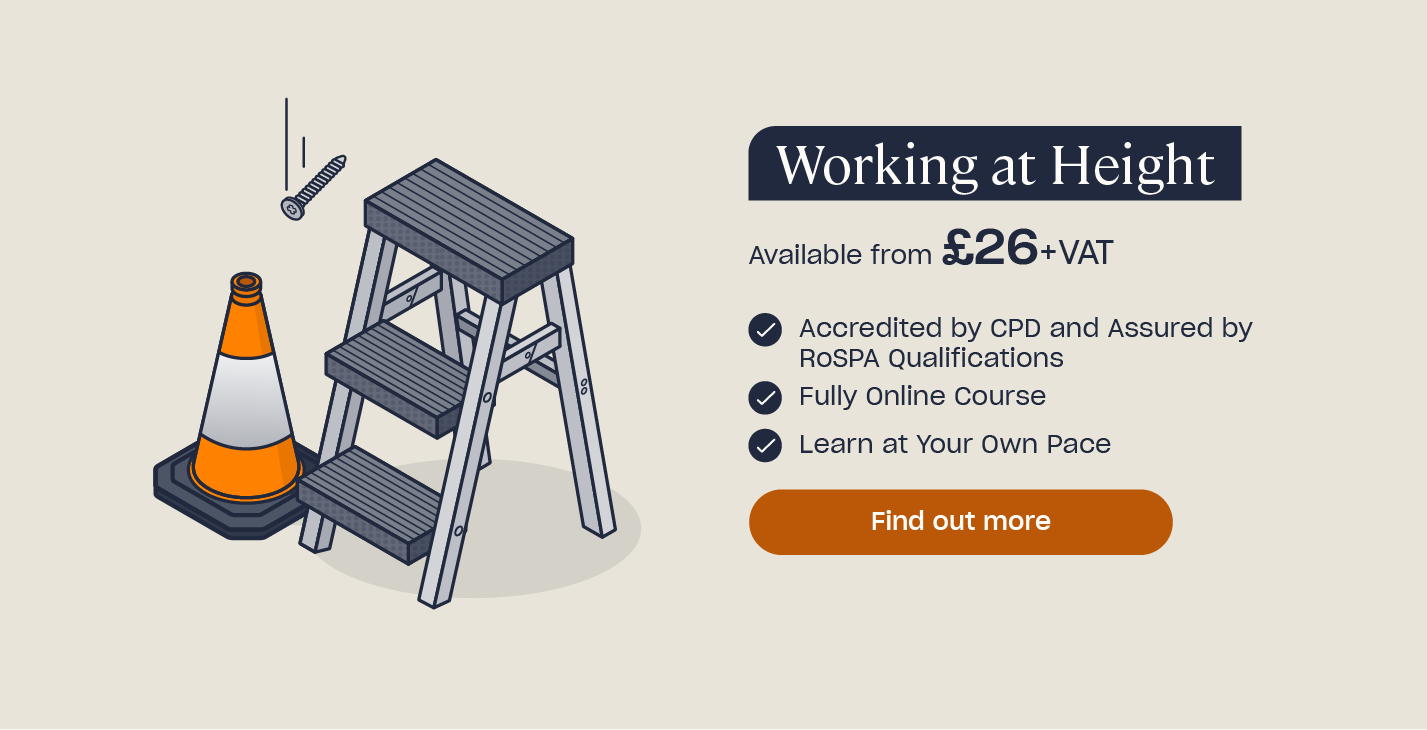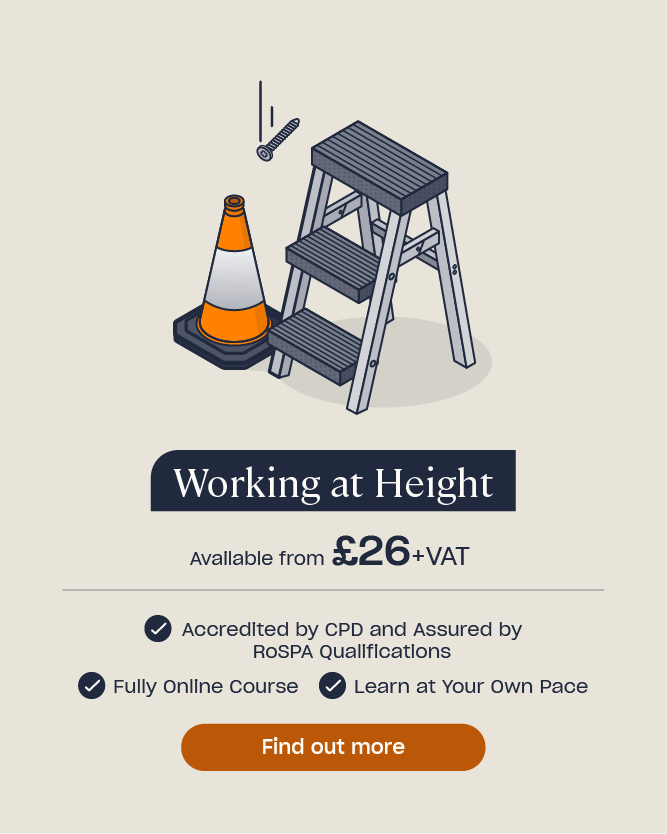What is Scaffolding Safety for Working at Height?
This article has been written in conjunction with a Health & Safety specialist.
Scaffolding is a temporary structure used to gain access to work at height and to support people and materials for the work. Scaffolding consists of either individual components such as scaffolding tubes and fittings, or of prefabricated sections that are joined together. In Great Britain, traditional scaffolding consists of scaffolding tubes and fittings that are secured together and on which are laid wooden or metal boards or platforms, which with suitable handrails and toe boards provide a safe working platform for people and any necessary materials.
Scaffolding is used extensively in the construction, maintenance and repair of buildings and other structures such as industrial plant. It is also used to provide access to inspect, service or repair parts of structures or machines as well as for gaining access to places of work at height which are otherwise difficult to access. Scaffolding is used in many settings, not only for construction but for many other types of work.
In this article, we will outline some of the scaffolding safety requirements and examine the safety measures that need to be in place in order to protect you and those around you. We will also look at the most commonly used types of scaffolding.
What are Scaffolding Safety Requirements?
Work at height is the largest single cause of fatal accidents at work. 50% of all fatal accidents in the construction industry, and 25% in other industries, are caused by falls from height. It is also a substantial cause of major injury accidents that result in extensive time away from work.
Accidents mainly happen while getting access to, or leaving, the work location or while working at height. Falling materials and falling work equipment are other serious risks of working at height. Life-threatening injuries have occurred when materials have fallen on people who are passing below those working at height.

Scaffolding Safety Legislation
The Work at Height Regulations 2005 (WAH) apply to access to and work at height and to all work at height activities – whether in factories, warehouses, construction sites or in offices. Therefore, whether you are an employer or an employee, if your workplace requires any sort of work at height, it’s essential to understand what you can do to reduce the risk and consequences of a fall.
The WAH Regulations require employers to ensure that work at height is properly organised and planned by competent people, who understand the hazards and risks of working at height and the correct control measures.
The Regulations also require that suitable work equipment is selected in a hierarchy as follows:
- First, avoid the risks by doing the task without working at height – for example, using long poles for window cleaning or using prefabricated structures.
- If avoidance of work at height is not reasonably practicable (that is, for work at height not technically possible) then falls must be prevented by providing work equipment that stops falls from happening in the first place. Scaffolding of all types fits into this category. Scaffolding is therefore one of the main methods of preventing falls and should be used if it is not reasonably practicable to avoid the work at height.
- The lowest level of the hierarchy is the mitigation of falls, for example, by the use of airbags, or the use of personal fall protection, such as safety harnesses and running lines. However, these types of mitigation equipment can only be used if it is not possible to prevent falls.
In most cases where work at height has to take place, prevention of falls by using scaffolding or other forms of working platform (such as cherry pickers) must be selected by employers before equipment like harnesses.
The next section of this article will focus on the main types of scaffolding that can be selected, exploring the benefits and challenges of each type. The WAH Regulations require that competent personnel are in control of the selection of safe scaffolding and that anyone erecting, altering and dismantling the scaffolding is trained in the safe erection, alteration and dismantling of the specific type of scaffolding. You will find more guidance on this later in the article.
What are the Main Types of Scaffolding in Construction?
There are three commonly used forms of scaffolding. These are:
- Fixed scaffolding.
- Mobile towers.
- Low level mobile towers and podium steps.
Fixed Scaffolding
Fixed scaffolding is what is commonly seen on buildings or other structures. In the UK ‘tube and fitting’ scaffolding is commonly used. This consists of individual tubes and fittings, such as couplers, along with scaffolding boards and toe boards and other protection such as brick guards.
There is also a wide variety of proprietary scaffolding systems. These are either in the form of separate components such as proprietary designed tubes with connectors or as modular systems, consisting of individual sections that are connected together.
There are also specialised forms of scaffolding such as cantilever or suspended scaffolding.

Design of fixed scaffolding
In all cases, those managing and working on the erection, dismantling or alterations of scaffolding must be competent. In many cases, specialist companies or scaffolding providers carry out any work that requires substantial scaffolding structures and each scaffolding project is individually designed.
For tube and fitting scaffolding design in the UK, there is guidance for standard design configurations for tube and fitting scaffolding. It can be found in the National Access and Scaffolding Federation (NASC) guidance book TG20 – ‘A comprehensive guide to good practice with tube and fitting scaffolding’. This guidance is important for those engaged in planning and carrying out the erection, alteration and dismantling of the standard designs of tube and fitting scaffolding.
For proprietary systems or modular scaffolding equipment, the manufacturer draws up the designs and issues erection guidance which needs to be followed.
For all types of scaffolding that are outside of the standard designs in TG20 or in the manufacturers’ instructions, then a competent person should carry out the design. Examples of these types of fixed scaffolding include suspended or cantilever scaffolding that are not to standard design, or other specialised scaffolding, such as shoring structures.
It is essential that a copy of the erection plan, standard or specialised, is available to those supervising and erecting scaffolding and that they are informed and instructed in its requirements. The next section will consider the safe erection of scaffolding.
The safe erection, alteration and dismantling of fixed scaffolding
As already mentioned, scaffolding can only be erected, significantly altered or dismantled under the supervision of a competent person and by those who have received training in the specific type of scaffolding.
The Construction Industry Scaffolders Record Scheme (CISRS) and CISRS Card is recognised as evidence of training that is suitable for the type of scaffolding that the card specifies. Scaffolding equipment manufacturers and independent training companies also offer specific training on different types of scaffolding equipment.
Often workers are employed to act as ‘scaffolding labourers’. These personnel should only ever assist trained erectors and should remain in a safe place, either on the ground or on a permanent structure, or on a fully erected platform with guardrails and toe boards.
It is essential that there is a safe method of erecting any type of scaffolding. The NASC has produced guidance, ‘Preventing falls in scaffolding operations’ and manufacturers also produce detailed guidance on how to safely erect and dismantle their equipment.
Supervision by a competent trained person must be available at all times. This means that, during work, a fully trained scaffolding erector, or erectors, are on site at all times. For larger or more complex operations, a supervisor should be on site or regularly visiting, depending on the complexity of the scaffolding and the nature of the site.
It is essential that any scaffolding that is left incomplete (for example, at the end of a working day) is made safe. Any ladders or other access must be removed and stored or secured so that they cannot be used by others. Warning signs should be posted – for example, ‘incomplete scaffolding’. Physical barriers should also be put into position. There have been fatal accidents to children and others who have entered building sites or scaffolding when it is incomplete.
Cleanliness, tidiness and safe storage of equipment are essential at all times, both during erection and dismantling and when the scaffolding is in use. Any loose materials must be safely stored, including while waiting to be installed on the scaffolding, both to prevent trips and to prevent them becoming dislodged and falling from the scaffolding. It is important to keep accessways, platform ladder access points and stairways free of any obstruction both during erection and in use.

Handover and inspections of fixed scaffolding
There should be written evidence that the scaffolding has been erected to a design or to manufacturer’s guidance. This is often referred to as a ‘handover certificate’. The employer who will use the scaffolding must ensure that they have received the handover certificate and understand the safety aspects of the scaffolding that have been set out – for example, the number of ties in the scaffolding. Any areas of doubt must be checked on handover.
The employer using the scaffolding should ensure that simple visual checks are made regularly (daily if necessary) on the general condition of the scaffolding, the access and the working platforms.
Such simple checks include checking that:
- Sole plates and base plates are correctly in position, the standards are upright and evenly spaced.
- Access ladders and stairways are properly installed and secure. Ladders must be sufficiently long and at an angle of 75 degrees.
- Work platforms are fully boarded and there are no missing boards or toe boards.
- Handrails are in position (a minimum of a top handrail and middle handrail) and are secured.
- Any ties that are in the handover certificate are in place and firmly fixed.
- Access is unobstructed along working platforms.
Statutory inspections of scaffolding
The WAH Regulations set out the legal duty for statutory inspection of all types of scaffolding as follows:
- Before the scaffolding is first used by any person.
- At least every seven days, or more frequently if specified by the designer.
- When there is an event that may have affected the stability or condition of any part of the scaffolding.
Events include bad weather including wind and rain, storms, earth movement or structural movements.
The person carrying out the statutory inspections should be trained – there are many scaffolding courses for inspecting scaffolding provided by different organisations.
Mobile Access Towers
Mobile towers (traditionally called ‘scaffolding towers’) are a useful method of carrying out work that is of short duration, on firm and level ground or another firm surface. It is also essential that there are no obstructions, in particular overhead power lines. Remember that some overhead power lines may not be easily recognised. A competent supervisor should check in advance for obstructions or overhead power lines at the locations of use of any mobile tower. Alternative safe methods of work may then be required and set out in a risk assessment.
Training of erectors
As with scaffolding, those erecting mobile towers should be trained in their safe erection, alteration and dismantling. There are several forms of techniques that have been developed. One technique uses advance guardrails and another technique is known as ‘through the trap’ (3T) training.
In both cases, the erector must have training in the specific erection system, and the employer must ensure that the correct additional safety equipment is available, for example, the advance guardrails, and that all equipment is in good condition.
Safe use of mobile towers
Many accidents have been caused during the use of mobile towers. From time to time, they overturn, or strike another structure trapping a person, or are incomplete, with guardrails and braces missing.
A common cause of overturning is their use on sloping ground. The risk assessment needs to consider the specific uses of the mobile tower and ensure that all elements are covered. For example, a tower may have to be dismantled and re-erected if there are areas of unsafe or sloping ground.
Inspection of mobile towers
Similar requirements for statutory inspections apply to mobile towers, as for other scaffolding. That is, inspection before use, after seven days or after an adverse event. If the tower is moved on site, it should be inspected every seven days in its new position.
Tower systems and low-level access
There is a significant use of low-level tower systems such as ‘room scaffolds’ or podium steps. These structures are a scaffolding framework with an inbuilt platform that can be folded and transported around the site. These podium steps or low-level towers give access to the tops of room walls or other lower-level access needs. The heights of the inbuilt platform can vary from 0.5 to 1.5 metres or more. In all cases, the podium steps should be properly maintained and inspected regularly by a nominated person who understands the safety elements of the equipment.
In addition, it is essential to ensure that podium steps and low-level towers are used in safe locations and that they rest on a firm, level surface and are the correct size for the work needed.
If podium steps are to be used near to a high fall risk, for example on balconies, near shafts or other areas where there is a fall to a lower level, then there is a need to carefully assess the situation. It needs to be ensured that there is no need to reach over the high fall area, which would create risks of overbalancing and falling from a significant height. In cases where there is such as need, substantial edge protection and working platforms should be used instead of low podium steps or other low-level access equipment.
Further Resources:
- Working at Height Training Course
- Working at Height Rescue Plan
- Working at Height Rules and Regulations
- Safely Securing Ladders: Guidance & Procedure
- How to Become a Scaffolder







